A blog by Michael Hannah and Stella McCulloch
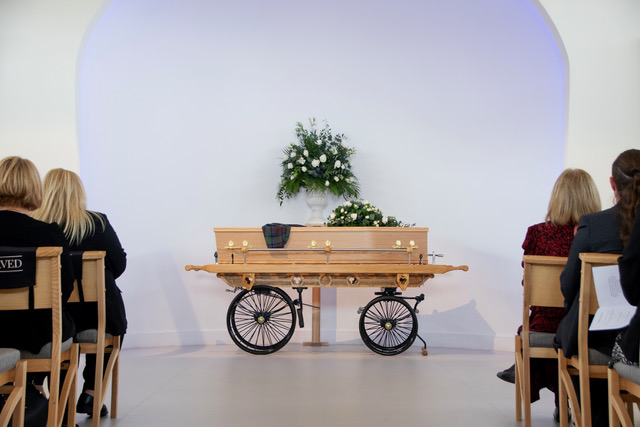
Each year in May, Good Life Good Death Good Grief co-ordinates activities across Scotland as part of Demystifying Death Week. It’s all about giving people knowledge, skills and opportunities to plan and support each other through death, dying, loss and care. As such it represents a significant contribution to death education in Scotland, and indeed death literacy, where the latter is defined as “a set of knowledge and skills that make it possible to gain access to, understand, and act upon end-of-life and death care options” (Noonan et al., 2016, p. 31).
Stella McCulloch and I are both MSc students of the End of Life Studies Programme (former student in my case!). We are also funeral celebrants and members of the Scottish Independent Celebrants’ Association (SICA). We thought readers of the End of Life Studies blog might be interested in SICA’s 2024 contribution to Demystifying Death Week: two “staged” funerals held at Brewsterwells Crematorium near St Andrews.
Staging the Funeral – A Question of Image
SICA’s plan stemmed from conversations with colleagues at the Good Funeral Guide. In 2021 they staged four funerals in London to create a body of professional images that their members could use on websites, social media etc. Unlike weddings, funerals present ethical challenges to capturing images. SICA’s aim was to emulate the event in a Scottish setting, enlisting our own members and guests to play various roles. To enable this, we secured permission to use Brewsterwells Crematorium on a Sunday.
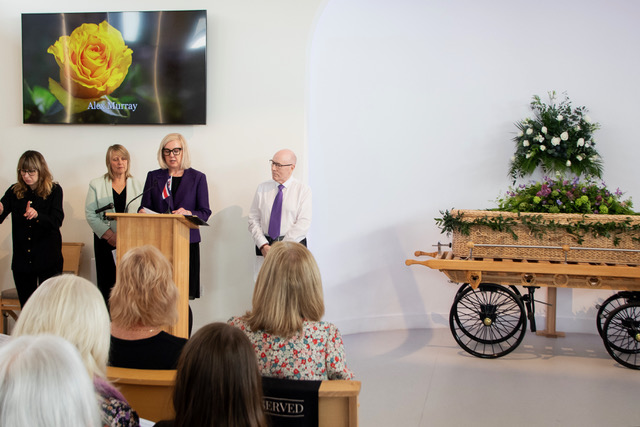
We quickly realized that the event had significant potential for death education and what we might term “funeral literacy”. We envisaged using the visual materials to illustrate what actually happens in a typical funeral and what options are available – demystifying the funeral. We foresaw the potential to create a blueprint for future events exploring different types of funerals and involving diverse audiences.
The two funerals were planned to be as authentic as possible. Two members, myself and Gillian Robertson each led on one ceremony as celebrant. SICA members and guests played roles of family, friends, and mourners. We organised: music; flowers; a hearse and coffins from William Purves Funeral Directors; and engaged a BSL interpreter.
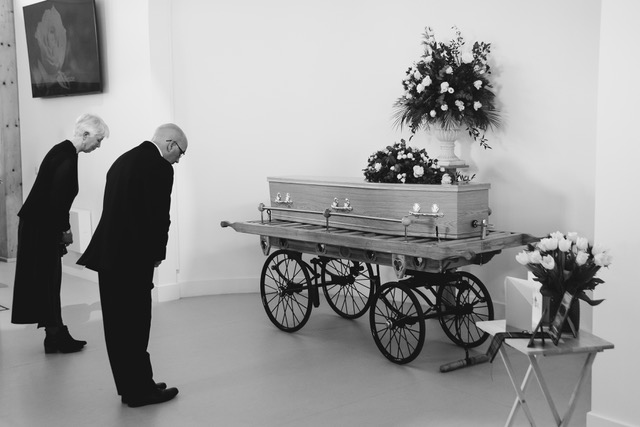
Critically, we sourced a photographer, Jenn Knox, whose work with the charity Remember my Baby underlined her sensitivity to issues of loss. We also commissioned a videographer, Lee Philips, to record the day.
Bringing the Dead to Life
And so we began to create the stories of Alex Murray and Iain MacKenzie. I worked on Alex’s funeral and wrote a basic biography. This was circulated, along with Iain’s, to everyone who agreed to take part. Our aim was to ensure that these two imagined people be as well known by attendees in advance of the funeral as possible (even to the extent of attendees slightly changing their dress between services). Gillian and I then used these biographies to write their eulogies.
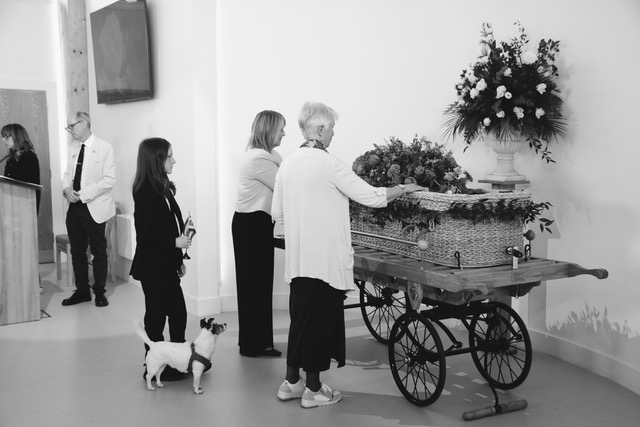
The process of writing was in itself a fascinating one. I based Alex’s life on elements drawn chiefly from two people, myself and a woman whose funeral I had conducted last year. I also included fictitious elements that allowed me to illustrate certain points. For example, I had Alex work for three years in Latin America so that I could “welcome” those watching from afar (by livestream), read a tribute from a Costa Rican friend, and place a little flag on the coffin.
I created a sister and two friends, each of whom was played by a celebrant. Stella was a friend from Glasgow University days! All three were asked to write their own tributes. Stella commented:
Considering that we had not collaborated beforehand, I thought that the words of Cate, Ian and I flowed together really well. Reading Michael’s eulogy had given us a really good flavour of the person that Alex was, which then made it easier to write about her. We each wrote from a different perspective, based on our own relationship, which made for a personalised funeral, where all those in attendance found out something new about Alex. I always feel that a service has been executed well if people leave feeling that they now know that person better than they did on arrival.
Although the elements of Alex’s life were fictitious or drawn from different people, there was conscious effort to create biographical coherence in the stories. We also went to great lengths to ensure that people as far as possible had a “real” funeral experience. Stella noted that:
It was the little details that made it feel so real… an authentically decorated coffin, family and friends sharing their reflections on Alex, and of course Cate’s wee dog Millie, playing the role of Alex’s own dog. I was quite invested with Alex’s friends watching on the livestream, and had to remind myself that there was no livestream or indeed anyone from Costa Rica watching!
Building legacy
Such observations recalled work I had covered in my MSc dissertation on the shift towards celebrant-led funerals in Scotland. A great deal has been written on biography, funeral rhetoric and meaning making. For example, Tony Walter suggests that a funeral biography can help mourners “find an enduring place for the deceased in their lives” (Walter, 1996, p. 22), and Douglas Davies devotes a whole book to his theories of “words against death” (Davies, 2017). What strikes me as especially fascinating is our sense of Alex and Iain coming to life. An unexpected result of a funeral perhaps, but could this suggest the value of staged funerals as potentially fruitful avenues of research into funeral rhetoric and meaning-making?
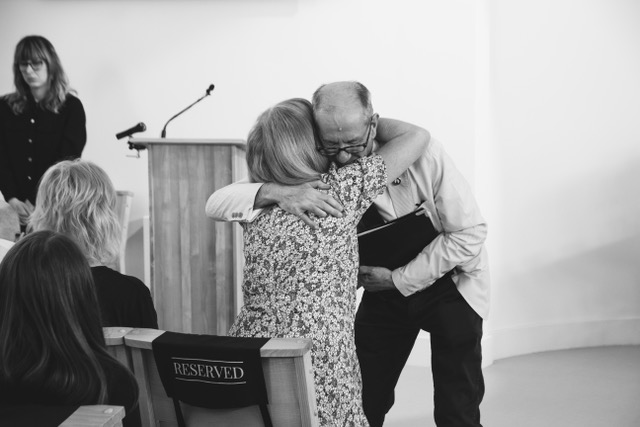
On a more immediately practical level, for SICA the event promises to be useful in a number of ways. The photographs and video will promote our work, our members and our commitment to funeral literacy. And the event was a valuable opportunity for peer-to-peer professional development and sharing of good practice. Stella noted that as celebrants we are so focused on delivering a good service, we can forget what it’s like to be a mourner and all the emotions that invokes. The staged funeral allows us to give thought to all people in attendance, not just immediate family, and to the intricacies of their relationship to the deceased person. We shared advice, ideas and took a moment to think afresh about what a funeral is and who it is for.
A fitting legacy for Iain MacKenzie and Alex Murray.
REFERENCES
- Davies, D., 2017. Death, Ritual and Belief: The Rhetoric of Funerary Rites. 3rd ed. London: Bloomsbury Academic.
- Noonan, K., Horsfall, D., Leonard, R. and Rosenberg, J., 2016. Developing death literacy. Progress in Palliative Care, 24(1), pp.31–35.
- Walter, T., 1996. A new model of grief: Bereavement and biography. Mortality, 1(1), pp.7–25.
IMAGES
All images are the property of the Scottish Independent Celebrants’ Association. However, we welcome enquiries about using and sharing these and other images and video. Please contact Michael Hannah, Chair SICA, on 07712 892479 or contact https://celebrants.scot/contact/


[…] am delighted to see that the University of Glasgow End of Life Studies blog has published my post. I wrote it in collaboration with my friend and celebrant […]